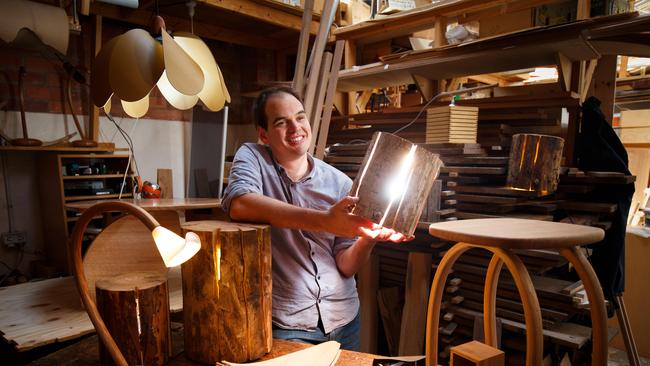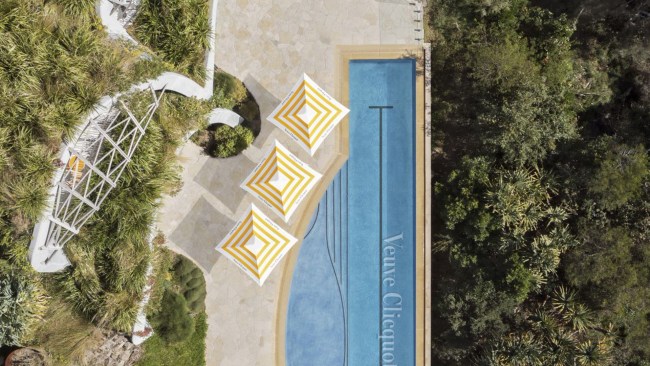Shining through the cracks
How blind lighting designer Duncan Meerding takes inspiration from Tasmania’s natural environment.

Designer Duncan Meerding has built his name with a functional furniture piece that creates a feeling of warmth and comfort on cosy nights.
His cracked log lamps have become his trademark, an acclaimed and uniquely Tasmanian work that has become sought after for its soothing, campfire feel.
Meerding says the log lamps are particularly popular among inner-city dwellers who are “craving that natural feel and that natural look”, and the snuggly, soothing sense of Tasmania in winter.
The lamps meld salvaged and sustainable local wood and a warm, diffused light perfect for long, romantic nights with a pinot or mulled wine.
The lamps, which evoke the feeling of a crackling fireplace within a log, are the product of an island that has awakened Duncan Meerding’s senses in extraordinary ways.
The thirty-something Hobart resident has lost more than 95 per cent of his vision yet incredibly has become one of Australia’s most exportable furniture designers, recently returning from presenting his latest creation, a sleek propeller lamp, at the world’s largest lighting design show, Milan’s Euroluce deLIGHTful exhibition.
Meerding’s work and life are fuelled by an environment he experiences yet can’t quite see.
“Tasmania is quite unique in terms of its natural environment and I find wherever I go I feel more relaxed and get the sudden inspiration for designs,” he says.
“And Hobart in particular, it’s one of those rare places you walk out the back door and there’s wilderness straight away,” Meerding adds.
“Every suburb in Hobart borders some sort of parkland or reserve; it’s fairly rare and that influences a lot of people. Most of us have some affinity with the outdoors and most people — given that opportunity — would also want to be living (like that).”
One of the designer’s favourite places, kunanyi/Mt Wellington, is just up the street from his home. The often snow-capped peak affords extravagant views through Tasmania’s crisp, flawless air and its walls feature exposed, and rare, dolerite rocks.
“We’ve got rock formations there that are pretty unique to Australia, and quite unique wilderness,” he marvels.
Meerding’s art and design is informed by such tactile and different textures.
Having had a condition that destroyed his central vision, Leber’s hereditary optic neuropathy, since he was 18, Meerding only sees peripheral light. Consequently, the smells, sounds and touches of his environment are essential.
His acclaimed log lamps mix his connection with the sense of touch to his limited vision. The specially-chosen logs disperse
light through the cracks and around the form with soft LED lights, bringing dim, warm lighting to the unhewn wood.
The logs also enhance his own, and Tasmania’s, passionate vision for sustainability. Much of the physical materials Meerding uses, for many works, are salvaged woods from the island’s enchanted forests.
“The idea is to utilise something that would otherwise be wasted,” he says. His log lamps embrace their imperfections counterintuitively “because cracks are something that’s often shied away from in design.”
“The problem with some design is it’s all around trends and not about lasting a lifetime,” he adds. He wants his furniture to be passed on down generations, as it once was.
Meerding uses faster-growing timbers such as Tasmanian eucalyptus and blackwood, avoiding old-growth woods such as myrtle and Huon pine. Tasmania is dominated by 1.2 million hectares of untouched old growth forests, more than one million hectares of which is permanently protected in reserves.
The bounteous forests are scrupulously protected by Forestry Tasmania yet open and available for pristine sensory experiences.
“Everywhere has a degree of this but the fact we’ve got so much wilderness and are trying to maintain it is such a strong point,” Meerding says of an island that offers myriad alpine walks, campfires and snuggly lodges during the colder months. “A lot of wilderness here doesn’t have that corporate, say, glass-panelled restaurant feel that some do. It has maintained that dense environment.”
It’s a density that heightens your sensations, particularly in winter. The soothing trees colour Meerding’s days, breaking the sun’s warm light into something he can feel. “For me, if I walk with dappled light through the trees, it just evokes a sense of relaxation,” he says.
Meerding feels comfortable in Tasmania. Its sensations become his work; its warmth and history provides him confidence and community.
He notes Tasmania has a long tradition of building and making things from wood and the designer-maker tradition has been an essential part of the island’s being, if not image. He’s discovered kindred spirits in not only sustainability but in the strong arts and design communities in Tasmania.
The Design Tasmania co-operative supported his first foray into design — after a close friend thought he was joking about becoming a designer — with their shared space being one of the first of its type in the country.
Meerding says Tasmania stimulates his senses on so many levels. “If someone comes to visit Tasmania, they’d walk around and realise it’s fairly sleepy compared to the big cities but there’s still so much going on, in the arts, in the strong wilderness theme and in the community,” Meerding notes.
“It is hard to explain Tasmania without coming here because it is quite a unique place.”
This content was produced in association with Tasmania — Go Behind The Scenery. Read our policy on commercial content here.


